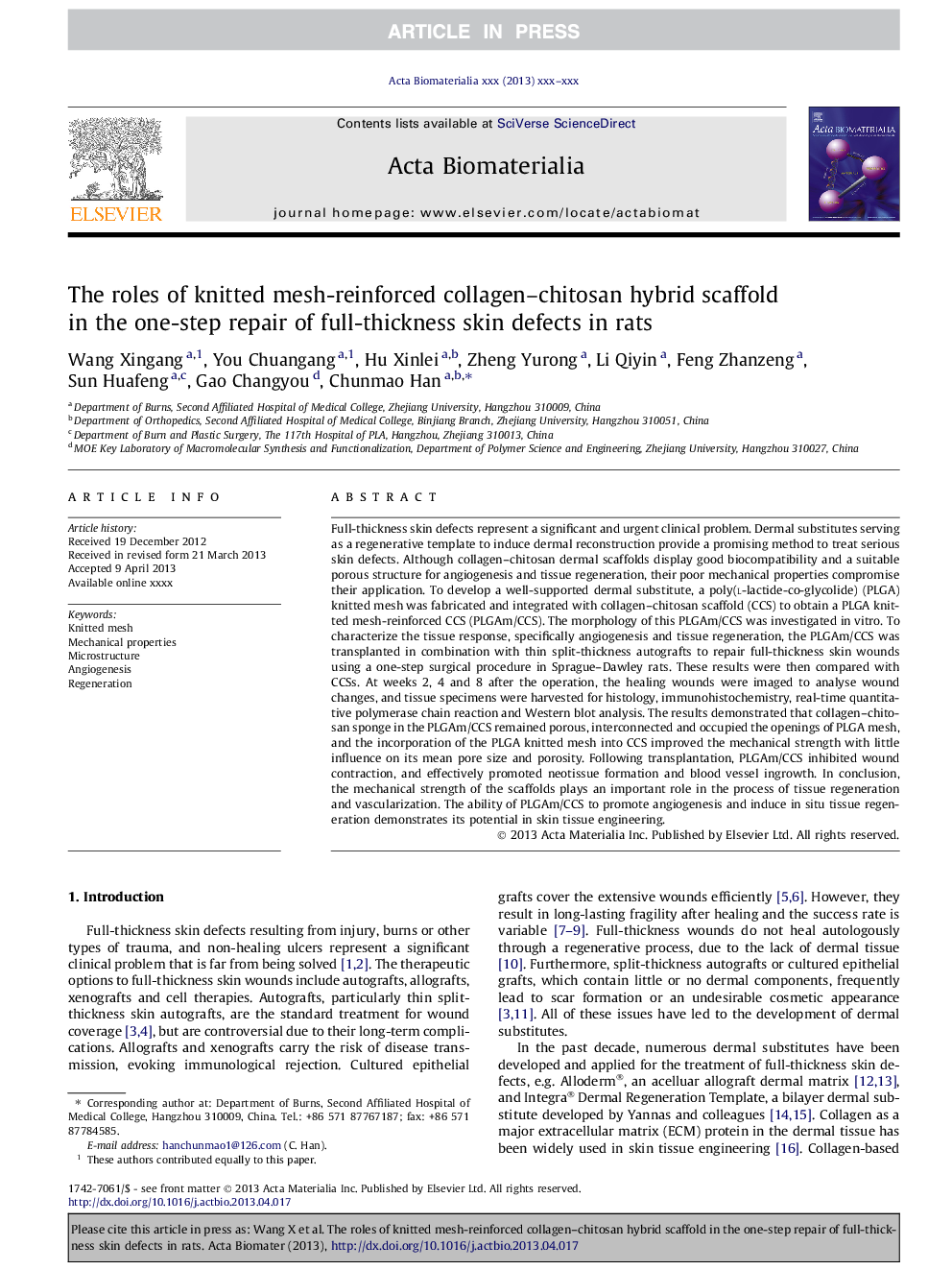| کد مقاله | کد نشریه | سال انتشار | مقاله انگلیسی | نسخه تمام متن |
|---|---|---|---|---|
| 10159614 | 54 | 2013 | 11 صفحه PDF | دانلود رایگان |
عنوان انگلیسی مقاله ISI
The roles of knitted mesh-reinforced collagen-chitosan hybrid scaffold in the one-step repair of full-thickness skin defects in rats
ترجمه فارسی عنوان
نقشهای داربست هیبرید کلاژن-کیتوزان هیبرید تقویت شده بافتنی در تعمیر یک مرحله ای نقصهای پوستی کامل در موش صحرایی
دانلود مقاله + سفارش ترجمه
دانلود مقاله ISI انگلیسی
رایگان برای ایرانیان
کلمات کلیدی
مش بافتنی، ویژگی های مکانیکی، ریز ساختار، آنژیوژنز، بازسازی،
موضوعات مرتبط
مهندسی و علوم پایه
مهندسی شیمی
بیو مهندسی (مهندسی زیستی)
چکیده انگلیسی
Full-thickness skin defects represent a significant and urgent clinical problem. Dermal substitutes serving as a regenerative template to induce dermal reconstruction provide a promising method to treat serious skin defects. Although collagen-chitosan dermal scaffolds display good biocompatibility and a suitable porous structure for angiogenesis and tissue regeneration, their poor mechanical properties compromise their application. To develop a well-supported dermal substitute, a poly(l-lactide-co-glycolide) (PLGA) knitted mesh was fabricated and integrated with collagen-chitosan scaffold (CCS) to obtain a PLGA knitted mesh-reinforced CCS (PLGAm/CCS). The morphology of this PLGAm/CCS was investigated in vitro. To characterize the tissue response, specifically angiogenesis and tissue regeneration, the PLGAm/CCS was transplanted in combination with thin split-thickness autografts to repair full-thickness skin wounds using a one-step surgical procedure in Sprague-Dawley rats. These results were then compared with CCSs. At weeks 2, 4 and 8 after the operation, the healing wounds were imaged to analyse wound changes, and tissue specimens were harvested for histology, immunohistochemistry, real-time quantitative polymerase chain reaction and Western blot analysis. The results demonstrated that collagen-chitosan sponge in the PLGAm/CCS remained porous, interconnected and occupied the openings of PLGA mesh, and the incorporation of the PLGA knitted mesh into CCS improved the mechanical strength with little influence on its mean pore size and porosity. Following transplantation, PLGAm/CCS inhibited wound contraction, and effectively promoted neotissue formation and blood vessel ingrowth. In conclusion, the mechanical strength of the scaffolds plays an important role in the process of tissue regeneration and vascularization. The ability of PLGAm/CCS to promote angiogenesis and induce in situ tissue regeneration demonstrates its potential in skin tissue engineering.
ناشر
Database: Elsevier - ScienceDirect (ساینس دایرکت)
Journal: Acta Biomaterialia - Volume 9, Issue 8, August 2013, Pages 7822-7832
Journal: Acta Biomaterialia - Volume 9, Issue 8, August 2013, Pages 7822-7832
نویسندگان
Wang Xingang, You Chuangang, Hu Xinlei, Zheng Yurong, Li Qiyin, Feng Zhanzeng, Sun Huafeng, Gao Changyou, Chunmao Han,
